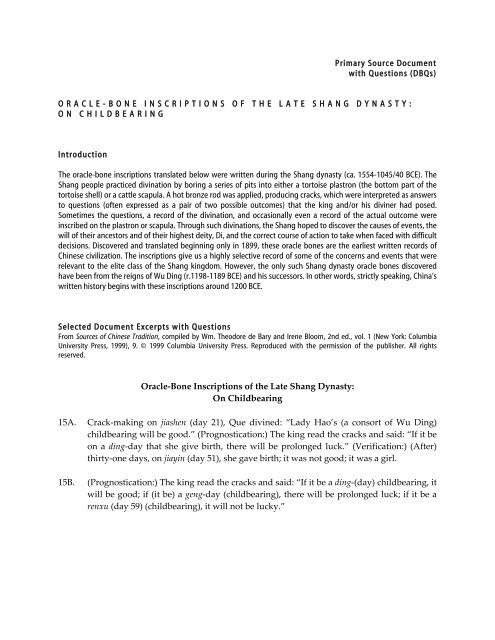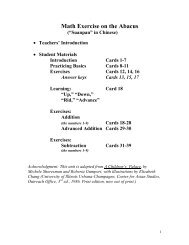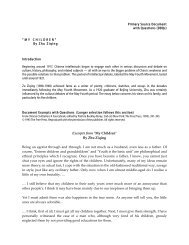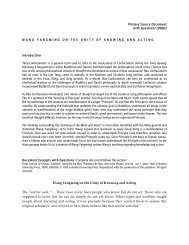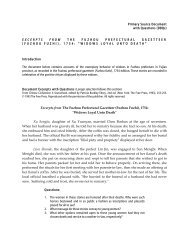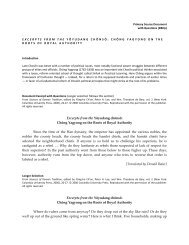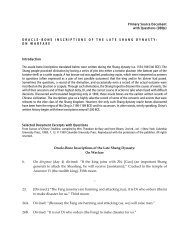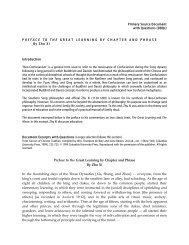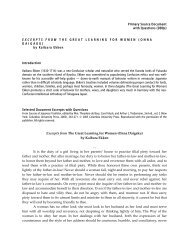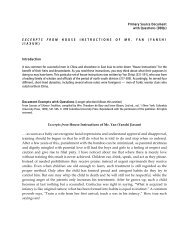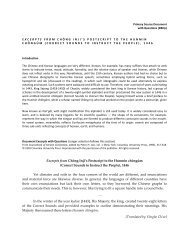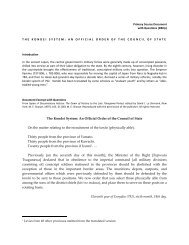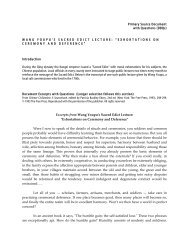ORACLE-BONE INSCRIPTIONS OF THE LATE SHANG DYNASTY
ORACLE-BONE INSCRIPTIONS OF THE LATE SHANG DYNASTY
ORACLE-BONE INSCRIPTIONS OF THE LATE SHANG DYNASTY
- No tags were found...
You also want an ePaper? Increase the reach of your titles
YUMPU automatically turns print PDFs into web optimized ePapers that Google loves.
Primary Source Documentwith Questions (DBQs)<strong>ORACLE</strong>- <strong>BONE</strong> <strong>INSCRIPTIONS</strong> <strong>OF</strong> <strong>THE</strong> <strong>LATE</strong> <strong>SHANG</strong> <strong>DYNASTY</strong>:ON CHILDBEARINGIntroductionThe oracle-bone inscriptions translated below were written during the Shang dynasty (ca. 1554-1045/40 BCE). TheShang people practiced divination by boring a series of pits into either a tortoise plastron (the bottom part of thetortoise shell) or a cattle scapula. A hot bronze rod was applied, producing cracks, which were interpreted as answersto questions (often expressed as a pair of two possible outcomes) that the king and/or his diviner had posed.Sometimes the questions, a record of the divination, and occasionally even a record of the actual outcome wereinscribed on the plastron or scapula. Through such divinations, the Shang hoped to discover the causes of events, thewill of their ancestors and of their highest deity, Di, and the correct course of action to take when faced with difficultdecisions. Discovered and translated beginning only in 1899, these oracle bones are the earliest written records ofChinese civilization. The inscriptions give us a highly selective record of some of the concerns and events that wererelevant to the elite class of the Shang kingdom. However, the only such Shang dynasty oracle bones discoveredhave been from the reigns of Wu Ding (r.1198-1189 BCE) and his successors. In other words, strictly speaking, China’swritten history begins with these inscriptions around 1200 BCE.Selected Document Excerpts with QuestionsFrom Sources of Chinese Tradition, compiled by Wm. Theodore de Bary and Irene Bloom, 2nd ed., vol. 1 (New York: ColumbiaUniversity Press, 1999), 9. © 1999 Columbia University Press. Reproduced with the permission of the publisher. All rightsreserved.Oracle‐BoneInscriptionsoftheLateShangDynasty:OnChildbearing15A. Crack‐making on jiashen (day 21), Que divined: “Lady Hao’s (a consort of Wu Ding)childbearingwillbegood.”(Prognostication:)Thekingreadthecracksandsaid:“Ifitbeon a ding‐day that she give birth, there will be prolonged luck.” (Verification:) (After)thirty‐onedays,onjiayin(day51),shegavebirth;itwasnotgood;itwasagirl.15B.(Prognostication:)Thekingreadthecracksandsaid:“Ifitbeading‐(day)childbearing,itwillbegood;if(itbe)ageng‐day(childbearing),therewillbeprolongedluck;ifitbearenxu(day59)(childbearing),itwillnotbelucky.”
Primary Source Document, with Questions (DBQ) on<strong>ORACLE</strong>-<strong>BONE</strong> <strong>INSCRIPTIONS</strong> <strong>OF</strong> <strong>THE</strong> <strong>LATE</strong> <strong>SHANG</strong> <strong>DYNASTY</strong>: ON CHILDBEARINGQuestions:1. What do the inscriptions indicate about the relative status of males andfemales in the Shang family structure?2. What cultural characteristics would explain the desire for a male child?3. How does the concern expressed here compare to the ideals of othercivilizations in other times and places?Asia for Educators | Columbia University | http://afe.easia.columbia.edu Page 2 of 2


